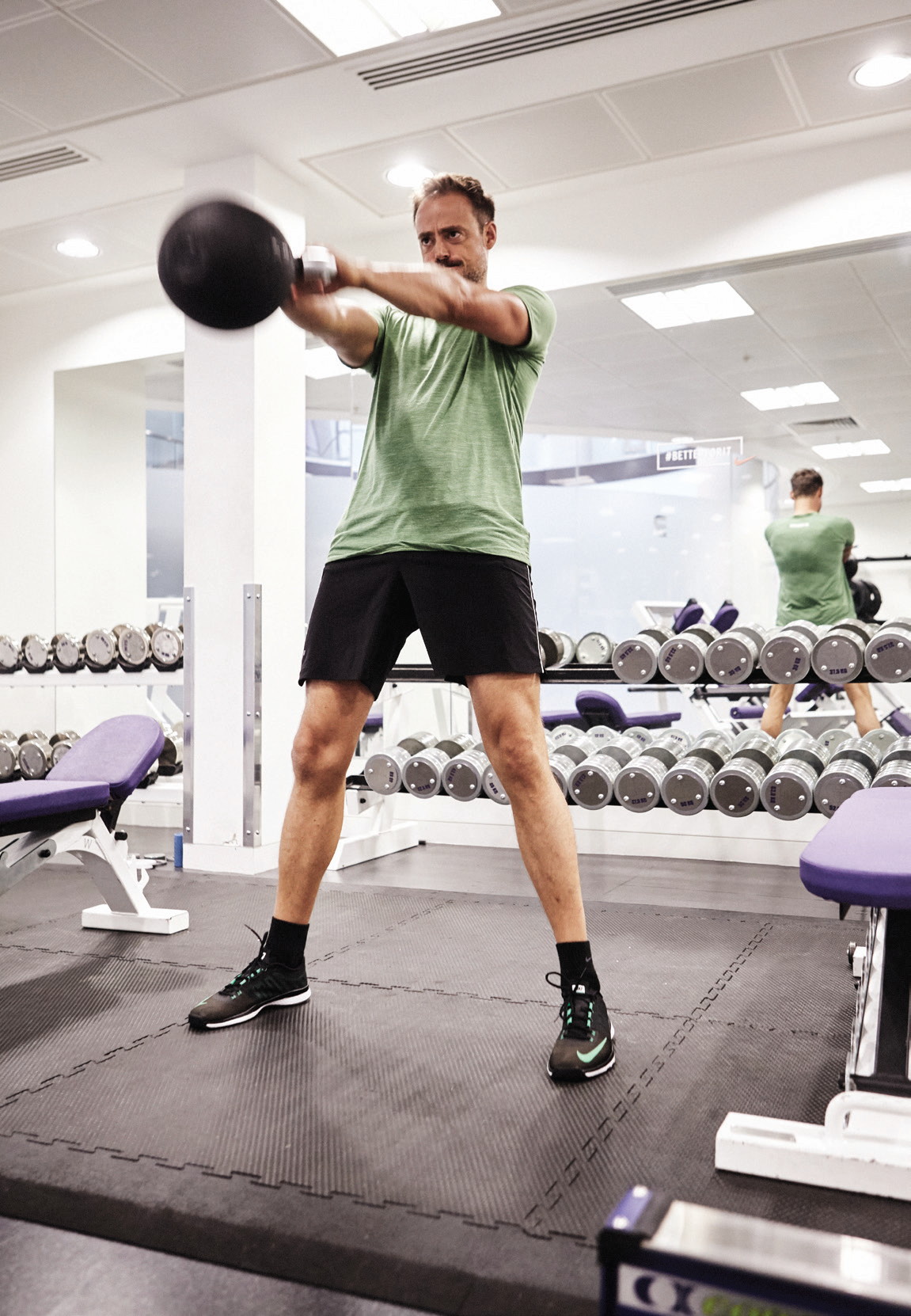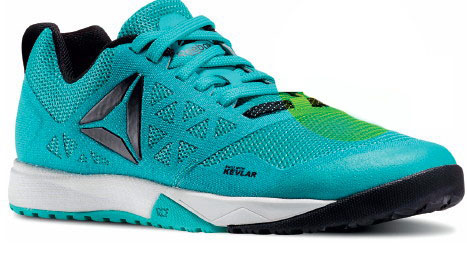Anyone who works in an office knows the temptations of the 4pm biscuit run, the Friday doughnut round and the swift post-work half. As it turns out, things aren’t much different in a radio booth: except that the volume gets turned up.
“There’s always some kind of ‘week’ on,” says Jamie Theakston, Heart FM’s man in the morning. “Curry week, pie week, pizza week – we’d get sent that stuff, and so we wouldn’t feel bad about eating it first thing in the morning.”
At the other end of the schedule, late-night shifts for TalkSPORT’s Andy Goldstein meant frequent runs at the station’s (now-defunct) vending machine. “It wouldn’t be unheard of for me to have four packets of crisps in a shift,” says the Andy Goldstein’s Sports Bar presenter. “I was slowly getting obese.” Neither man knew much about weight training or nutrition – and the pair had never met before MF and London’s Embody Fitness gym challenged them to recapture their former glory. So were they ready for the real HIIT parade?
In years gone by, the one-time presenter of C4’s The Games was quite the sportsman – fencing for Sussex, playing club cricket, winning a Man of the Match trophy in Soccer Aid 2010 – but injuries and life got in the way. “When I was active it was easy for me to drink and eat what I wanted, and I would never get any heavier than about 15 stone [95kg],” says Theakston. “When you’re 6ft 4in [1.93m] your height can hide a multitude of sins, but at the end of last year I was struggling to fit into anything I could buy off the peg. I had a 38in waist: I remember thinking, ‘That’s quite big’.”
Theakston had barely looked at a weight before, so early training – with Embody’s Chris Walton – was a struggle. “I said to Chris that parts of my body that I didn’t know existed were hurting, and I thought I was physically unable to do the things he wanted me to do,” says Theakston. “He said it’d get easier and I didn’t believe him. But he was right.”
The real education for Theakston, though, came with his new diet. “I didn’t know the difference between protein and carbohydrate,” he says. “I’ve never taken much notice. I’d be in the studio at 5am, then I’d have a breakfast at 6.30 and maybe another one at 8.30, and it was sausage or bacon sandwiches, tonnes of coffee… looking back it’s kind of shocking.” He discovered it was about changing bad habits.
“People persuade themselves that they ‘need’ a big breakfast to start the day, but it’s just what they’ve always had. Now I have two eggs with porridge and that’s it.”
Now he’s in his best shape for over a decade. “You see it in the little things, like running upstairs: a year ago, I was carrying an extra three stone up. I feel brighter, my complexion’s better, all of those things.”
To anyone thinking of changing their own lifestyle, his advice is simple: “Don’t be afraid of the challenge. The hardest bit is the first couple of weeks. Then it keeps getting better.”

Back on track
Heart FM’s Jamie Theakston got his diet right – and the fat dropped off
Pumping up the volume
“The first goal for both Jamie and Andy was to start stripping some body fat and develop good movement patterns, as both guys had been pretty sedentary for a while,” says Chris Walton, director of training at Embody Fitness. “Jamie had also had a shoulder reconstruction a few weeks earlier so we had to go light on a lot of the upper-body work and also include quite a lot of rehab for his scapula, rotator cuffs and so on.” This targeted session does just that, before Theakston moved on to the tougher moves pictured.
1 Standing anti-rotation hold
Sets
2Reps
20Rest
30sec
Stand perpendicular to a cable machine and hold the cable at shoulder height, resisting the weight of the machine without moving. Do 30 seconds on each side for one set.
2 Step-up with single-arm press
Sets
2Reps
10Rest
60sec
Step up onto a box or bench, and press a dumbbell overhead with the opposite arm to your lead leg.
3A Dumbbell split squat
Sets
3Reps
10Rest
30sec
Holding a dumbbell in each hand, step forward into a lunge, bending your front knee until your rear knee brushes the ground. Straighten your leg, then lower again.
3B Isolateral row
Sets
3Reps
10Rest
60sec
You’ll need the machine for this one. Sit in the saddle and pull the handle down with one arm. Control it on the way up.
4A Cable pull-through
Sets
4Reps
8Rest
30sec
Set up a cable rope attachment at just above knee height, and grip the cable between your legs. Pull it forward by straightening your hips, as if you were doing a deadlift.
4B Bench press
Sets
4Reps
8Rest
30sec
Grip the barbell, brace your core and lower slowly, keeping your feet flat on the floor. However much you want to up the weight, don’t bounce it – aim to make each rep brush your T-shirt.
5 Rowing intervals
Distance
100mSets
6Rest
40sec
Your goal for 100m: get it under 20 seconds.




Session artist
TalkSPORT’s Andy Goldstein ditched the all-dayers and the treadmill for the real wheels of steel
“I was slowly getting obese,” says Goldstein, about the moment he decided to make some changes. “For me the turning point was around Christmas when I went to the darts. I had about ten pints and a hot dog, and on the way home I had six nuggets, two hamburgers and a large fries, and didn’t think anything of it.”
Goldstein’s no stranger to training, with a handful of half and full marathons under his belt, but he’d always avoided the weights room. “Like a lot of people, I was scared to lift heavy weights,” he admits. “I’d be on the treadmill for an hour.” To put on functional muscle and burn fat, Embody’s Chris Walton gave him a programme of compound exercises with low rest. “I don’t believe in bodybuilding splits for new clients,” Walton explains. “If you only train one body part once a week, you’re resting it for too long. We’d superset upper and lower body moves, never going below about six reps. We pushed both guys hard.”
Goldstein had also tried diets before – “the 5:2 fast, the smoothies” – but this transformation required lasting changes. “The first three days were tough because I couldn’t eat any of the crap I normally have, but after that it was a breeze,” he says. “For breakfast I’d have chicken or steak or salmon. People pull a face when I say that, but then I wouldn’t get hungry for hours. It’s not like it would take me an hour to make – there’s no excuse for not eating healthy.” Binges were replaced by new habits. “I’ve got into black coffee now,” he says. “I’ll still have a curry, but with a healthy sauce. I have 95% chocolate for a treat – I don’t need to indulge myself all the time.”
For Andy, the work outside the gym made bigger changes than the lifting inside it. “When I met Chris he said, ‘There’s 168 hours in a week and I’ve got you for three of them, so the rest is up to you’. Other people can help keep you on the road, but you’ve got to want it. Everyone’s got it in them. Don’t think of it as an end – think of it as a new way of life.”

Fine tuning
“The training sessions towards the end were much more focused on trying to add some lean muscle,” says Walton.
“As neither guy had done much weight training, we were still able to keep reps fairly high because they would still respond positively – from a lean mass perspective – to relatively high reps. They trained three times a week with me, and supplemented that with some high-intensity interval work on their own.” Here’s one of Goldstein’s typical lean mass sessions.
1A Side step-up
Sets
4Reps
6 each sideRest
30sec Stand holding heavy dumbbells with a box to one side of you, and step up onto it. After you’ve done all your reps on one side, turn around and do it again leading with the other leg.
1B Semi-supinated lat pull-down
Sets
4Reps
10Rest
30sec
Hold the pull-down handle with your palms facing in – this targets your biceps, and it’s easier on the elbows. Pull the weight down strongly, and control it on the way up.

2A 1¼ goblet squat
Sets
3Reps
8Rest
30sec
Holding a kettlebell by the “horns”, drop into a squat so your elbows touch your knees. Come a quarter of the way up, drop down again and then stand up. That’s one rep.

2B Bench press
Sets
3Reps
10Rest
30sec
For a power boost, squeeze the bar: it’ll fire up the surrounding muscles, letting you squeeze out an extra rep or two.
3A Dumbbell push press
Sets
3Reps
10Rest
30sec
Holding a pair of dumbbells at shoulder height, bend your knees slightly and then use the momentum to drive them overhead.

3B Lateral step-over
Sets
3Reps
12 each sideRest
30sec Set up a low bench and hop over it, touching it with each foot at the top.
3C Renegade row
Sets
3Reps
12Rest
30sec
Gripping a pair of (preferably hexagonal) dumbbells, do a press-up, then row each dumbbell up to your armpit. That’s one rep.






